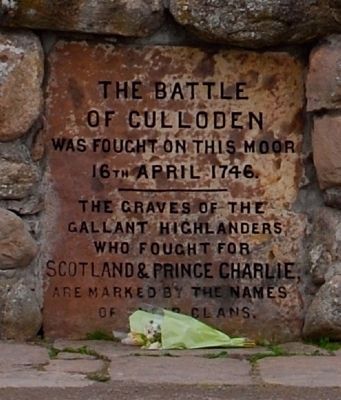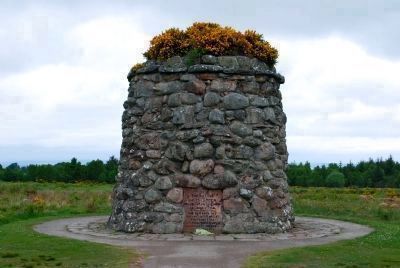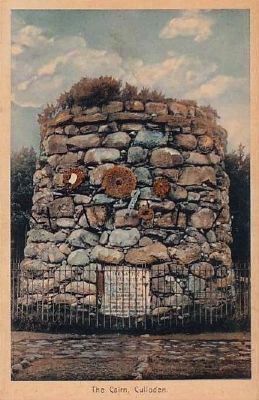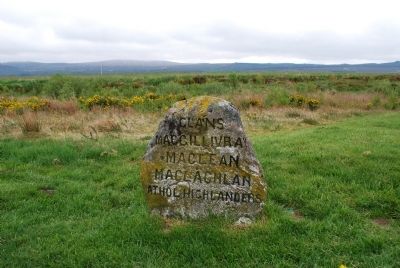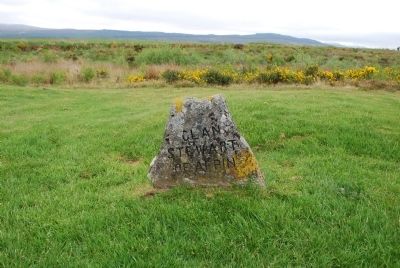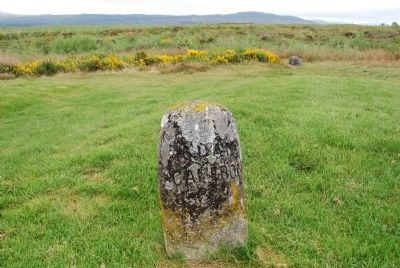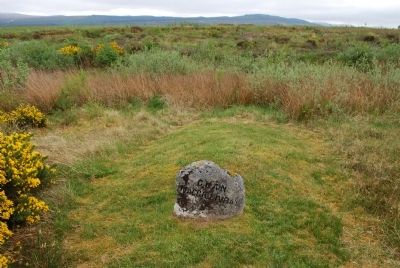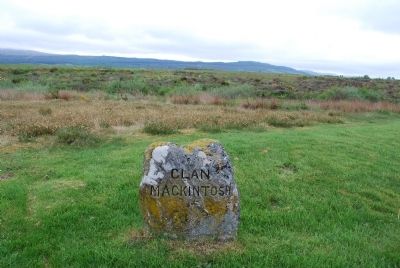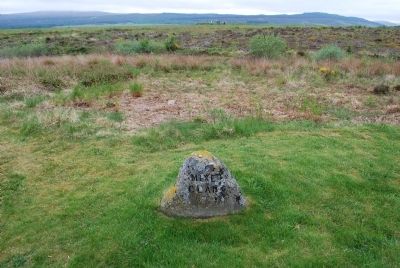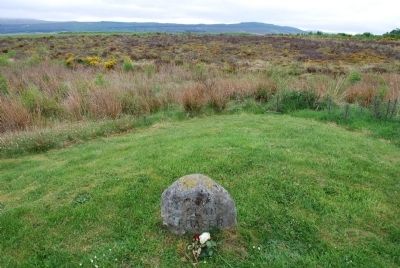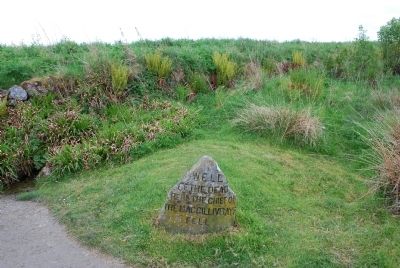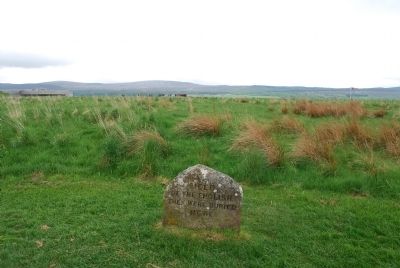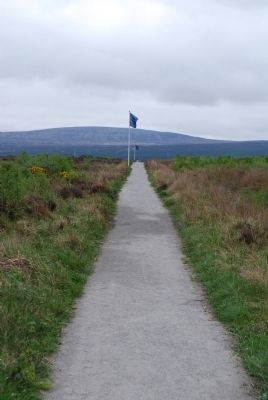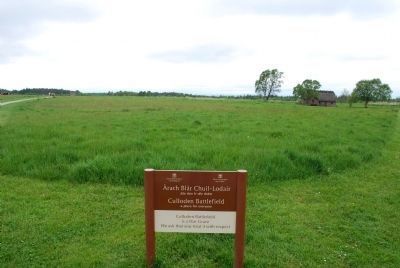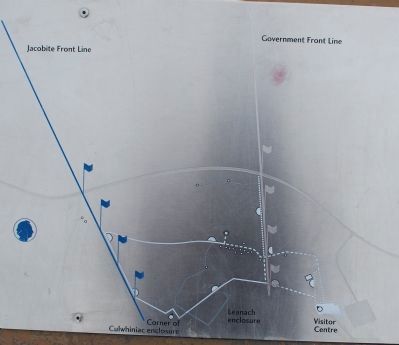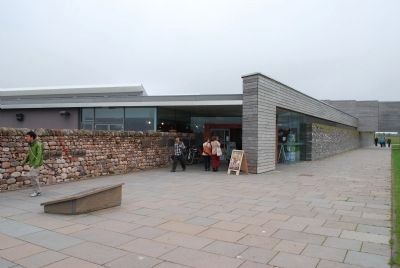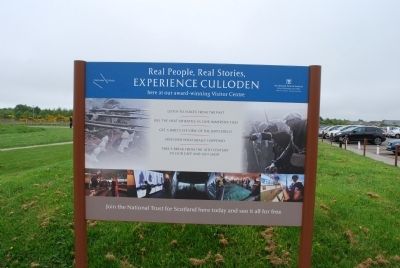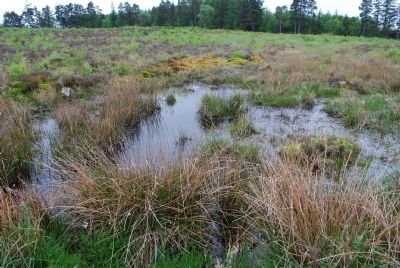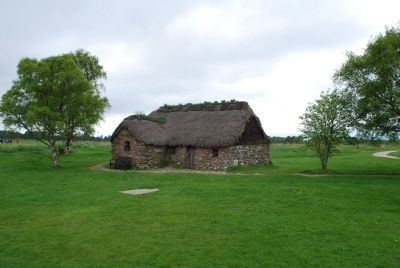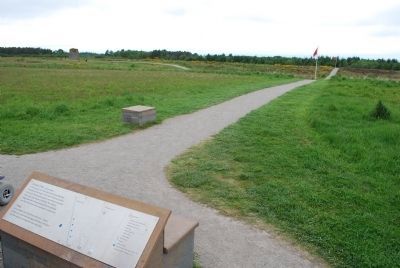Near Inverness in Highland, Scotland, United Kingdom — Northwestern Europe (the British Isles)
Culloden Battlefield
of Culloden
was fought on this Moor
16th April 1746
_____________________
The graves of the
gallant highlanders
who fought for
Scotland & Prince Charlie,
are marked by the names
of their clans.
Erected 1881 by Duncan Forbes.
Topics. This memorial is listed in this topic list: Wars, Non-US. A significant historical date for this entry is April 16, 1746.
Location. 57° 28.656′ N, 4° 6.001′ W. Marker is near Inverness, Scotland, in Highland. Memorial is on B9006, on the right. Touch for map. Marker is in this post office area: Inverness, Scotland IV2 5EH, United Kingdom. Touch for directions.
Other nearby markers. At least 8 other markers are within 11 kilometers of this marker, measured as the crow flies. Balnuaran of Clava (approx. 1.7 kilometers away); Inverness Castle (approx. 7.5 kilometers away); Inverness Castle Timeline (approx. 7.5 kilometers away); Flora MacDonald (approx. 7.5 kilometers away); Upstream, downsteam (approx. 7.5 kilometers away); Chapel Yard Cemetery (approx. 7.7 kilometers away); The Innes (approx. 7.8 kilometers away); Ardersier War Memorial (approx. 10.8 kilometers away). Touch for a list and map of all markers in Inverness.
Also see . . .
1. Culloden. The National Trust for Scotland's page for the Culloden Battlefield. Includes a narrative of the battle, as well as useful information for visitors. (Submitted on July 22, 2015, by Brandon Fletcher of Chattanooga, Tennessee.)
2. Culloden. The BBC's page for the Battle of Culloden. On its significance: Culloden is an evocative place for many people. Not only is it the site of the last full-scale battle to take place on British soil, and the last stand of an ancient royal dynasty which traced its ancestry back to the Dark Age Gaelic Kingdom of Dal Riata and beyond, but it is also the place where the Highland clan culture of Scotland sang its last song. The Battle of Culloden in 1746 meant, quite simply, the end of an era for Scotland. (Submitted on July 22, 2015.)
Additional keywords. Jacobite Uprising

Photographed By Brandon Fletcher, June 5, 2013
4. Culloden Battlefield Marker
The National Trust for Scotland
This cairn was placed in the care of the Trust in 1944 by Hector Forbes of Culloden.
It was erected in 1881 by his kinsman Duncan Forbes of Culloden, who also set up the headstones on the surrounding graves of the clans.
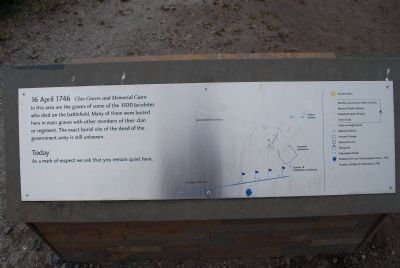
Photographed By Brandon Fletcher, June 5, 2013
16. Culloden Battlefield Marker
16 April 1746 Clan Graves and Memorial Cairn
In this area are the graves of some of the 1500 Jacobites who died on the battlefield. Many of them were buried here in mass graves with other members of their clan or regiment. The exact burial site of the dead of the government army is still unknown.
Today
As a mark of respect we ask that you remain quiet here.
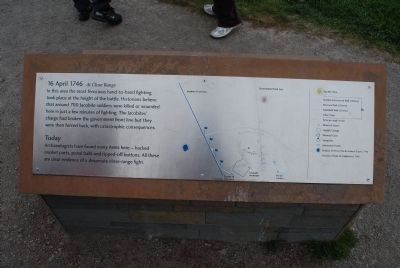
Photographed By Brandon Fletcher, June 5, 2013
17. Culloden Battlefield Marker
16 April 1746 At Close Range
In this are the most ferocious hand-to-hand fighting took place a the height of the battle. Historians believe that around 700 Jacobite soldiers were killed or wounded here in just a few minutes of fighting. The Jacobites' charge had broken the government line but they were then forced back, with catastrophic consequences.
Today archaeologists have found many items here- hacked musket parts, pistol balls and ripped off-buttons. All these are clear evidence of a desperate close-range fight.
Today archaeologists have found many items here- hacked musket parts, pistol balls and ripped off-buttons. All these are clear evidence of a desperate close-range fight.
Credits. This page was last revised on January 27, 2022. It was originally submitted on July 19, 2015, by Brandon Fletcher of Chattanooga, Tennessee. This page has been viewed 1,947 times since then and 149 times this year. Photos: 1. submitted on July 19, 2015, by Brandon Fletcher of Chattanooga, Tennessee. 2. submitted on July 22, 2015, by Brandon Fletcher of Chattanooga, Tennessee. 3. submitted on July 22, 2015. 4, 5, 6, 7, 8, 9, 10, 11, 12, 13, 14, 15, 16, 17, 18, 19, 20, 21, 22, 23, 24. submitted on July 19, 2015, by Brandon Fletcher of Chattanooga, Tennessee. • Andrew Ruppenstein was the editor who published this page.
